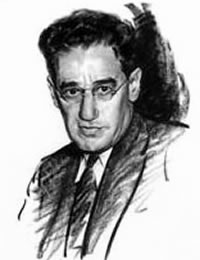Early Days
Early Days

George S. Kaufman
1889 – 1961
George S. Kaufman’s Biography
Early Days
Like many of the figures who glamorized New York City in the 1920s and 30s, Kaufman was born far from Manhattan high society.
In his case, he was born on November 16, 1888, into a middle-class Jewish Pittsburgh family who, according to him,
“managed to get in on every business as it was finishing and made a total of $4 among them.”
Lanky and laconic, the young Kaufman far preferred to immerse himself in plays and books – particularly those by Mark Twain.
After high school, he thought of studying law, but soon gave it up and moved to Manhattan in 1909 instead of pursuing a college education. He supported himself working in a hatband factory, while attending the theater and contributing small pieces of verse to Franklin Pierce Adams’ widely-read column in the Evening Mail.
Adams, recognizing a good comic writer, took Kaufman under his wing and got him a job, first on the Washington Times, and then, in 1917, on the New York Tribune as a drama desk reporter. Thanks to Adams’ encouragement, Kaufman began to get some notice as a humorist, and, he moved to the New York Times as a drama reporter in 1917, and soon became its drama editor, a post he held until 1930, long after he had earned his reputation as a dramatist.
That reputation began somewhat inauspiciously with the 1918 Broadway premiere of a heavily-doctored comedy about safecracking called Someone in the House by Larry Evans and Walter Percival, which Kaufman revised extensively. Its quick failure did not imbalance Kaufman’s equanimity; he suggested the following advertising slogan for the show, which played during an influenza epidemic:
“Avoid crowds. See Someone in the House.”
Like many of the figures who glamorized New York City in the 1920s and 30s, Kaufman was born far from Manhattan high society.
In his case, he was born on November 16, 1888, into a middle-class Jewish Pittsburgh family who, according to him,
“managed to get in on every business as it was finishing and made a total of $4 among them.”
Lanky and laconic, the young Kaufman far preferred to immerse himself in plays and books – particularly those by Mark Twain.
After high school, he thought of studying law, but soon gave it up and moved to Manhattan in 1909 instead of pursuing a college education. He supported himself working in a hatband factory, while attending the theater and contributing small pieces of verse to Franklin Pierce Adams’ widely-read column in the Evening Mail.
Adams, recognizing a good comic writer, took Kaufman under his wing and got him a job, first on the Washington Times, and then, in 1917, on the New York Tribune as a drama desk reporter. Thanks to Adams’ encouragement, Kaufman began to get some notice as a humorist, and, he moved to the New York Times as a drama reporter in 1917, and soon became its drama editor, a post he held until 1930, long after he had earned his reputation as a dramatist.
That reputation began somewhat inauspiciously with the 1918 Broadway premiere of a heavily-doctored comedy about safecracking called Someone in the House by Larry Evans and Walter Percival, which Kaufman revised extensively. Its quick failure did not imbalance Kaufman’s equanimity; he suggested the following advertising slogan for the show, which played during an influenza epidemic:
“Avoid crowds. See Someone in the House.”
Contact Us Today
Interested in bringing George S. Kaufman’s timeless plays to your stage?
Please refer to the contact information for each specific play on the various collection pages for direct amateur and professional licensing information.
Plays are represented by Concord Theatricals, Broadway Dramatic Licensing, and Music Theatre International respectively
If you are interested in first-class performance or film/television rights:
In the US, George S. Kaufman’s plays are represented by:
CPK Artists, LLC
In the UK, George S. Kaufman’s plays are represented by:
Alan Brodie Representation
For more information about George S. Kaufman or this website, contact:
Laurence Maslon
Literary Trustee, George S. Kaufman Estate









